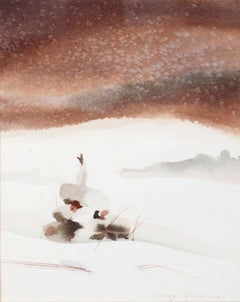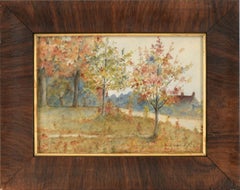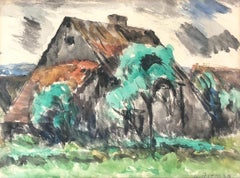Louis Ritman Drawings and Watercolor Paintings
Louis Ritman, Known primarily for his sunny, Impressionist landscape paintings, often with figures, earned much of his reputation for the work he produced during the time he was in Giverny, France, home of Claude Monet, a key Impressionist. Born in Kamenets-Podolsky, Russia, Ritman emigrated with his family to Chicago in 1903 and first traveled from his home in Chicago to Paris in 1910 when he could afford the art training there that so many American artists felt was crucial to professional achievement. Ritman enrolled at the Ecole des Beaux-Arts and the Academie Julian, but the turning point in his career was meeting Impressionist Frederick Frieseke at a cafe in Paris. Frieseke invited him to Giverny, where Ritman first went in 1911 and from that time his style changed from Academic to Impressionist. The small town with beautiful gardens and landscape vistas and quaint rural scenes was full of American artists including Frieseke and Richard Miller, with whom he painted. The atmosphere was one of encouraging artists to experiment with various styles of painting and Ritman returned each year until 1929. Ritman’s style is both Impressionist and Intimist, genteel and reserved in tone, with single figures, especially attractive young women, in confined landscapes and interiors. Ritman painted en plein air but often within his walled garden.
Early 20th Century American Impressionist Louis Ritman Drawings and Watercolor Paintings
Paper, Watercolor
Late 20th Century American Impressionist Louis Ritman Drawings and Watercolor Paintings
Paper, Watercolor
Early 20th Century American Impressionist Louis Ritman Drawings and Watercolor Paintings
Watercolor, Laid Paper
Late 19th Century American Impressionist Louis Ritman Drawings and Watercolor Paintings
Watercolor, Illustration Board, Laid Paper
1940s American Impressionist Louis Ritman Drawings and Watercolor Paintings
Paper, Watercolor
1960s American Impressionist Louis Ritman Drawings and Watercolor Paintings
Paper, Watercolor
21st Century and Contemporary American Impressionist Louis Ritman Drawings and Watercolor Paintings
Paper, Watercolor
Early 1900s American Impressionist Louis Ritman Drawings and Watercolor Paintings
Watercolor, Laid Paper
1930s American Impressionist Louis Ritman Drawings and Watercolor Paintings
Paper, Watercolor
1890s American Impressionist Louis Ritman Drawings and Watercolor Paintings
Paper, Watercolor
1990s American Impressionist Louis Ritman Drawings and Watercolor Paintings
Watercolor, Archival Paper
1910s American Impressionist Louis Ritman Drawings and Watercolor Paintings
Paper, Watercolor
1980s American Impressionist Louis Ritman Drawings and Watercolor Paintings
Paper, Watercolor
Early 20th Century American Impressionist Louis Ritman Drawings and Watercolor Paintings
Paper, Watercolor



